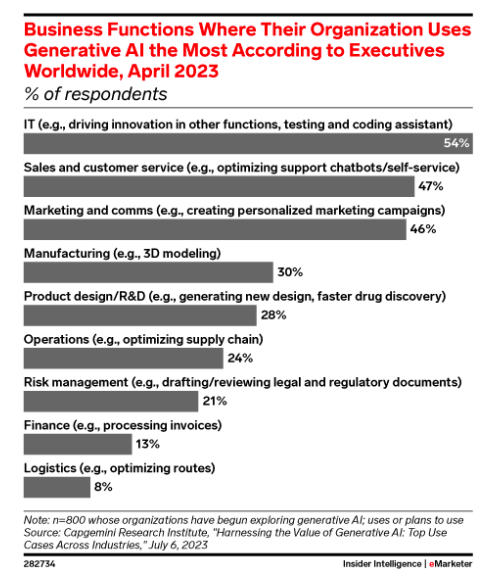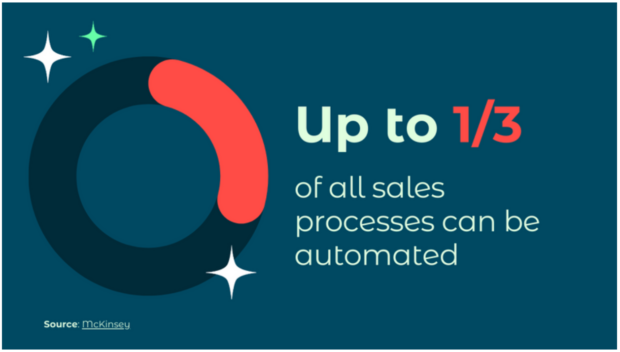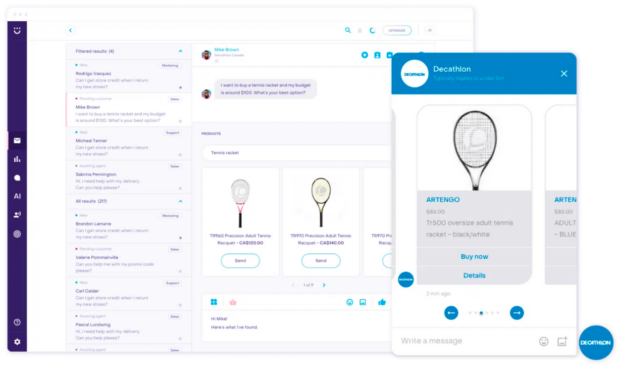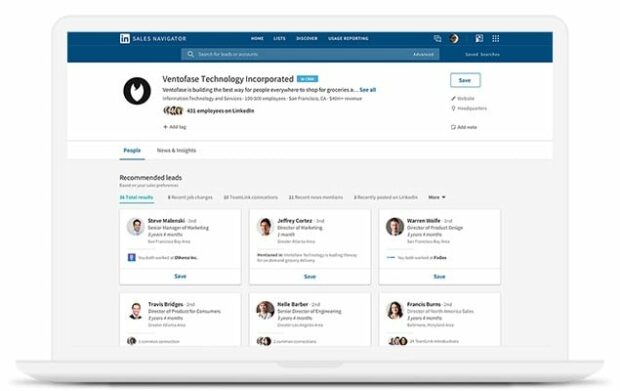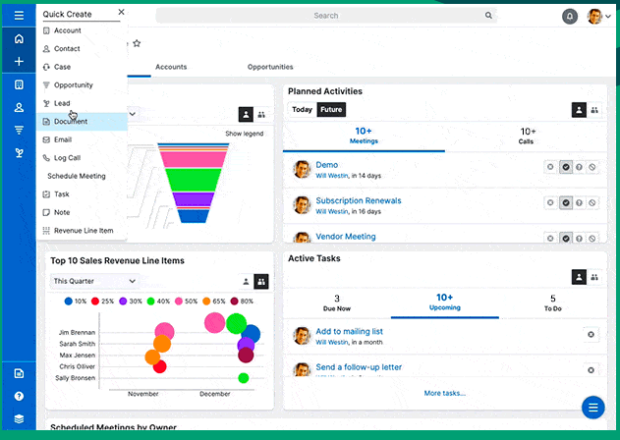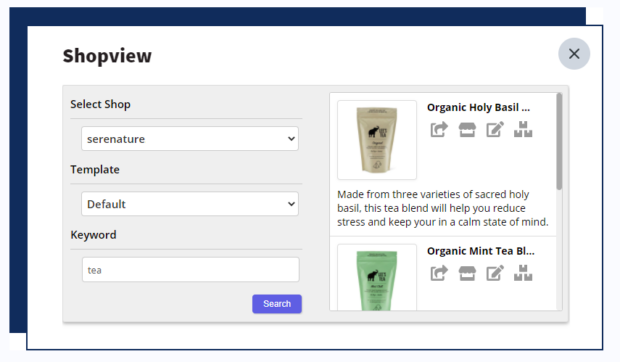What is Sales Automation? A Guide for Beginners
Sales automation is a hot topic for any business that sells — well — just about anything. And artificial intelligence is changing the automation game. It allows machines to take on more and more of the routine tasks that previously ate up big chunks of sales reps’ time.
In fact, sales and customer service automation is the second-most common area where business executives say they use generative AI.
Source: eMarketer
Keep in mind that sales automation is not about replacing sales reps with machines. Instead, it’s about handing off basic and repetitive tasks to automated tools. This allows sales reps to be more productive. It can also provide greater job satisfaction.
After all, reps want to spend their time selling, not crunching numbers and performing basic data entry tasks.
Bonus: Learn how to sell more products on social media with our free Social Commerce 101 guide. Delight your customers and improve conversion rates.
What is sales automation?
Sales automation is the use of automated tools to complete sales processes and streamline manual tasks.
For example, automated tools can take care of lead-nurturing email sequences and answer many customer questions. These administrative tasks can take up a huge amount of valuable employee time. And they often need to be done monthly, weekly, or even daily.
Outsourcing these tasks to sales automation software increases the productivity of your team. It allows more time for high-value tasks like prospecting and closing deals. And it costs a lot less than hiring a new assistant who happens to love repetitive labor. McKinsey found that it’s possible to automate up to one-third of all sales tasks.
In the social media sphere, sales automation tools connect the leads, prospects, and customers that come in through social channels with your sales team and your CRM. Sales automation tools don’t replace your sales team. Instead, they allow your team to make the most out of your sales pipeline by focusing on the most valuable elements of their work.
8 ways to use sales automation to grow your business
1. Sales process automation
Sales automation software increases your productivity and revenues. Businesses that use sales automation have reported a 10 to 15% increase in efficiency, and up to 10% higher sales.
That’s because sales and marketing automation tools can tackle important (but time-consuming) parts of the sales process, such as:
- identifying potential leads through social media listening
- sending personalized prospecting and follow-up emails
- scheduling meetings, appointments, and sales calls
- creating and monitoring proposals and contracts
- answering initial inquiries and common questions
- making product recommendations
When performed by humans, all of these tasks take away time from sales reps’ primary job: selling. When you offload the process-oriented work to automation tools and AI, you give your reps more time to do what they do best (and what they love).
You also avoid the potential human errors that happen when reps copy-and-paste messages to customers and prospects. We’d guess almost every sales rep out there has accidentally pasted the wrong name into an email salutation. Or forgotten to follow-up with a prospect in a timely manner. Or missed critical details about a lead’s personal or business situation when creating a contract. Sales process automation tools use templates and CR integrations to avoid these embarrassing errors.
2. Data collection and centralization
Collecting and managing data is crucial, but time-consuming. Sales automation software can take care of your customer and lead data automatically behind the scenes.
You’ll want a tool that integrates with all your lead sources and your customer service software. This creates one unified database that keeps all the important details in one place. That way all departments can build on one another’s efforts instead of stepping on one another’s toes.
This automated integration ensures you always have access to the most up-to-date data and conversations each customer and prospect has had with every member of your team. No matter which department spoke to them last. You can always determine which attributes your sales reps have access to and in which order.
Automating your data entry also ensures you have consistent records, with no duplicates.
3. Lead scoring
Only 10-15% of your leads will turn into sales. To maximize your ROI, you want to focus your efforts on the most valuable leads. Sales automation tools can help you with lead generation and lead scoring. This directs your efforts where they’re most likely to pay off in the sales funnel.
Sales automation tools track every interaction a lead has with your brand, whether it’s public or private. You can learn what they like, what they don’t, and spot trends that help you understand their purchasing behaviors and cycles.
This gives you a valuable, personalized knowledge base on each of your leads. You can identify when it’s time for an automated sales prompt and when it’s time for a sales rep to reach out.
When you connect, you’ll have a detailed profile based on multiple social channels and interactions. You’ll have everything you need to steer your conversation and guide your sales approach.
Your sales automation tools should also allow agents and admins to tag conversations either manually or automatically to prioritize the hottest leads.
4. Lead distribution
Sales automation tools use the contents of conversations to assign incoming leads to the most relevant sales rep. You can add skill sets within the automation tool so it knows which rep is the best fit for each type of inquiry.
Source: Hootsuite Inbox
This makes the lead distribution process more fair while ensuring leads get the most accurate response to their queries.

Manage all your messages stress-free with easy routing, saved replies, and friendly chatbots. Try Hootsuite’s Inbox today.
Book a Demo5. Customer satisfaction surveys
Customer satisfaction score (CSAT) is often thought of as a customer service metric. But it is also a helpful tool for sales automation. It helps you identify challenges in the interactions between your customers and your team. Any ongoing friction is a barrier to continued or future revenue.
A good sales automation tool enables automatic CSAT surveys for both human and chatbot interactions. The results are added to your CRM and provide additional context for future sales conversations.
Your sales automation tool should also allow automated CSAT reporting for both the overall team and on a per-agent/rep basis.
6. Order management and tracking
If you use an eCommerce platform like Shopify, automating order management is easy. There are a ton of apps that integrate directly into the platform. These can automate tasks like:
- generating invoices
- tracking shipping info and delivery updates
- recovering abandoned carts
- managing subscriptions
- automating loyalty programs.
Your sales automation tools also allow customers to track their own orders by interacting with a chatbot at any time of day. If there’s a complex problem that requires human intervention, the chatbot will refer the conversation to a human sales or customer service rep, so you maintain high CSAT scores.
7. Upselling
When a potential customer expresses interest in one of your products, they may be a good target for additional or premium product recommendations. An automated sales chatbot powered by AI (like Heyday by Hootsuite) can understand and recommend what a customer is looking for.
For example, say a customer asks about an entry-level service. The chatbot could ask clarifying questions to understand whether the offering is appropriate for their needs. If it’s not, or if add-ons would make the service more effective, the bot can make those recommendations. If the query is complex or large, the bot can refer the lead to a member of the sales team.
8. Reporting
Manually creating sales reports is nobody’s idea of a fun way to spend an afternoon. It’s a big job that can require sales reps and managers to gather data from multiple sources and waste time on data entry.
Sales automation tools can automate the sales reporting process. They include graphic components like charts and graphs that make the reports easier for everyone to understand at a glance.
Get data on important KPIs like qualified leads or new subscribers whenever you need them.
Source: Hootsuite Inbox
Plus, you don’t need to wait until the end of a sales period to understand what’s happening with your sales team. Sales automation tools offer real-time reporting so you can see what’s happening live, at any time.
Individual reps can check in on their own performance. Meanwhile, managers can access team-level reporting to keep everyone motivated and on track.
The best sales automation tools for 2023
Hootsuite
You might already know Hootsuite as a full-featured social media management platform. But it also offers an extensive array of sales automation functionality. One of the most valuable features within the main Hootsuite dashboard is the ability to set up social listening streams. This is a good way to watch for conversations related to your brand and identify prospects.
But the most important tools for sales automation live within Hootsuite Inbox. This unified social inbox bridges the gaps between social media engagement, sales, and customer service through:
- Automated message routing and filtering
- Auto-responses and saved replies
- Automatically triggered customer satisfaction surveys
- AI-powered chatbot features
- Automated tracking of all prospect interactions with your brand on social media (across your accounts and platforms)
- Automated response time and CSAT tracking and reporting
Hootsuite inbox also allows sales reps to add notes to customer profiles. These auto-update your CRM through integrations with tools like Salesforce and Microsoft Dynamics.
Salesforce
Salesforce is a top-rated CRM that is highly customizable for your business needs. It allows you to automate repetitive processes like email campaigns, approvals and data entry.
With Salesforce you can search and view leads, opportunities, accounts, contracts. When integrated with Hootsuite, Salesforce can identify and capture new leads from social channels.
Adobe Marketo
Marketo’s lead management features are triggered by real actions to help you understand what a prospect is likely to do next. You can create custom, real-time lead-scoring models to ensure your team is honed in on the prospects who are most likely to buy.
The robust data and lead management tools allow you to nurture prospects and qualify potential buyers automatically before your sales team invests their valuable time.
LinkedIn Sales Navigator
Source: LinkedIn Sales Solutions
LinkedIn Sales Navigator helps you find prospects using customized, targeted search tools. There’s no need to constantly log in and perform manual searches. Instead, you can set up a custom search filter and get email alerts when there are new profiles that match your results.
You can get alerts every day, every week, or every month, depending on how often you want to fill your funnel. You can then manage your leads within the platform, or integrate them with your CRM to access additional sales automation tools.
Microsoft Dynamics 365
Microsoft Dynamics unifies your sales and social marketing data. You get detailed insights about your customers and prospects. It uses artificial intelligence to predict customer intent and match your sales team with the highest quality leads.
Through an integration with Hootsuite, Microsoft Dynamics allows you to create leads and opportunities from social posts directly in your Hootsuite dashboard.
SugarCRM
Source: SugarCRM
SugarCRM offers AI-powered lead conversion and opportunity-close predictions. These keep your team focused on the best available leads. Real-time alerts provide important updates on key accounts, with data drawn from multiple sources. This includes social platforms.
When integrated with Hootsuite, SugarCRM allows you to pull in data directly from social posts. Full text search helps you find the smallest details in your database.
Shopview
Source: Synaptive
Do you use an ecommerce platform? There’s likely an available Shopview integration to connect your store to your social networks via Hootsuite. Shopview integrations facilitate social media sales automation. They allow you to share products to your social networks. You can filter products by collection and keyword, with multiple shop support.
You can also see all orders in your Hootsuite dashboard in real time.
Find your relevant Shopview integration in the Hootsuite App Directory:
Heyday
Source: Heyday
Heyday is a conversational AI assistant, designed to support your customers at every stage of their shopping journey. Heyday helps customers find the products they want, answers FAQs, and provides order updates. It can also support your sales team, by capturing leads and collecting data. It integrates with all your messaging channels to support customers everywhere.
Save time selling on social with automated responses, smarter workflows, and friendly chatbots — all in the Hootsuite Inbox.
Turn customer service conversations into sales with Heyday. Improve response times and sell more products. See it in action.
Free DemoThe post What is Sales Automation? A Guide for Beginners appeared first on Social Media Marketing & Management Dashboard.
Categories
- 60% of the time… (1)
- A/B Testing (2)
- Ad placements (3)
- adops (4)
- adops vs sales (5)
- AdParlor 101 (43)
- adx (1)
- AI (2)
- algorithm (1)
- Analysis (10)
- Apple (1)
- Audience (1)
- Augmented Reality (1)
- authenticity (1)
- Automation (1)
- Back to School (1)
- best practices (2)
- brand voice (1)
- branding (1)
- Build a Blog Community (12)
- Case Study (3)
- celebrate women (1)
- certification (1)
- Collections (1)
- Community (1)
- Conference News (1)
- conferences (1)
- content (1)
- content creation (11)
- content curation (1)
- content marketing (1)
- contests (1)
- Conversion Lift Test (1)
- Conversion testing (1)
- cost control (2)
- Creative (6)
- crisis (1)
- Curation (1)
- Custom Audience Targeting (4)
- Customer service (1)
- Digital Advertising (2)
- Digital Marketing (6)
- DPA (1)
- Dynamic Ad Creative (1)
- dynamic product ads (1)
- E-Commerce (1)
- eCommerce (2)
- Ecosystem (1)
- email marketing (3)
- Employee advocacy (2)
- employee advocacy program (1)
- employee advocates (1)
- engineers (1)
- event marketing (1)
- event marketing strategy (1)
- events (1)
- Experiments (31)
- F8 (2)
- Facebook (64)
- Facebook Ad Split Testing (1)
- facebook ads (18)
- Facebook Ads How To (1)
- Facebook Advertising (30)
- Facebook Audience Network (1)
- Facebook Creative Platform Partners (1)
- facebook marketing (1)
- Facebook Marketing Partners (2)
- Facebook Optimizations (1)
- Facebook Posts (1)
- facebook stories (1)
- Facebook Updates (2)
- Facebook Video Ads (1)
- Facebook Watch (1)
- fbf (11)
- first impression takeover (5)
- fito (5)
- Fluent (1)
- Get Started With Wix Blog (1)
- Google (9)
- Google Ad Products (5)
- Google Analytics (1)
- Guest Post (1)
- Guide (1)
- Guides (32)
- Halloween (1)
- Healthcare (1)
- holiday marketing (1)
- Holiday Season Advertising (7)
- Holiday Shopping Season (4)
- Holiday Video Ads (1)
- holidays (4)
- Hootsuite How-To (3)
- Hootsuite HQ (1)
- Hootsuite Life (1)
- how to (6)
- How to get Instagram followers (1)
- How to get more Instagram followers (1)
- i don't understand a single thing he is or has been saying (1)
- if you need any proof that we're all just making it up (2)
- Incrementality (1)
- influencer marketing (1)
- Infographic (1)
- Instagram (39)
- Instagram Ads (11)
- Instagram advertising (8)
- Instagram best practices (1)
- Instagram followers (1)
- Instagram Partner (1)
- Instagram Stories (2)
- Instagram tips (1)
- Instagram Video Ads (2)
- invite (1)
- Landing Page (1)
- Legal (1)
- link shorteners (1)
- LinkedIn (22)
- LinkedIn Ads (2)
- LinkedIn Advertising (2)
- LinkedIn Stats (1)
- LinkedIn Targeting (5)
- Linkedin Usage (1)
- List (1)
- listening (2)
- Lists (3)
- Livestreaming (1)
- look no further than the new yorker store (2)
- lunch (1)
- Mac (1)
- macOS (1)
- Marketing to Millennials (2)
- mental health (1)
- metaverse (2)
- Mobile App Marketing (3)
- Monetizing Pinterest (2)
- Monetizing Social Media (2)
- Monthly Updates (10)
- Mothers Day (1)
- movies for social media managers (1)
- new releases (11)
- News (79)
- News & Events (12)
- no one knows what they're doing (2)
- Non-profit (2)
- OnlineShopping (2)
- or ari paparo (1)
- owly shortener (1)
- Paid Media (2)
- People-Based Marketing (3)
- performance marketing (5)
- Pinterest (34)
- Pinterest Ads (11)
- Pinterest Advertising (8)
- Pinterest how to (1)
- Pinterest Tag helper (5)
- Pinterest Targeting (6)
- platform health (1)
- Platform Updates (8)
- Press Release (2)
- product catalog (1)
- Productivity (10)
- Programmatic (3)
- quick work (1)
- Real estate (4)
- Reddit (3)
- reels (1)
- Reporting (1)
- Resources (28)
- ROI (1)
- rules (1)
- Seamless shopping (1)
- share of voice (1)
- Shoppable ads (4)
- short-form video (1)
- shorts (1)
- Skills (25)
- SMB (1)
- SnapChat (28)
- SnapChat Ads (8)
- SnapChat Advertising (5)
- Social (150)
- social ads (1)
- Social Advertising (14)
- social customer service (1)
- Social Fresh Tips (2)
- Social listening (2)
- Social Media (5)
- Social media analytics (3)
- social media automation (1)
- social media content calendar (1)
- Social media content creation (2)
- Social media engagement (6)
- social media for events (1)
- social media management (2)
- Social Media Marketing (49)
- social media monitoring (1)
- Social Media News (4)
- Social media scheduling (1)
- social media statistics (1)
- Social media stats (1)
- Social Media Strategy (12)
- social media tools (8)
- social media tracking in google analytics (1)
- social media tutorial (2)
- Social Toolkit Podcast (1)
- Social Video (7)
- stories (1)
- Strategy (820)
- Template (2)
- terms (1)
- Testing (2)
- there are times ive found myself talking to ari and even though none of the words he is using are new to me (1)
- they've done studies (1)
- this is also true of anytime i have to talk to developers (1)
- tiktok (9)
- tools (1)
- Topics & Trends (3)
- Trend (12)
- Twitter (15)
- Twitter Ads (5)
- Twitter Advertising (4)
- Uncategorised (9)
- Uncategorized (13)
- url shortener (1)
- url shorteners (1)
- vendor (2)
- video (11)
- Video Ads (7)
- Video Advertising (8)
- virtual conference (1)
- we're all just throwing mountains of shit at the wall and hoping the parts that stick don't smell too bad (2)
- web3 (2)
- where you can buy a baby onesie of a dog asking god for his testicles on it (2)
- yes i understand VAST and VPAID (1)
- yes that's the extent of the things i understand (1)
- YouTube (13)
- YouTube Ads (4)
- YouTube Advertising (9)
- YouTube Video Advertising (5)

